What is a Life
jacket?
Life
jackets (also called PFDs - Personal
Fluotation Devices) provide face-up
flotation with sufficient levels of support that
can be applied in various water activities. Life
jackets have a buoyancy distribution sufficient
to turn the users to a position where the mouth
has a defined safe distance above the water
surface.
Things you should always keep in mind
A life jacket or a buoyancy aid will be
effective only if:
1. You have chosen the
right category and model, according to its
intended use
2. You have chosen the right
size, according to the weight and the size of
the user
3. You wear it properly
4. Wear
it at all times while at sea
Lalizas strongly
suggests that you test any new life jacket or
buoyancy aid in shallow water first. In this way
you can be certain that your choice is the
correct one. It is imperative that you wear a
buoyancy aid or a life jacket while on board or
during any water sport activity, since they will
save your life, should a problem occurs.
Foam Life Jacket 100N, CE ISO 12402-4::
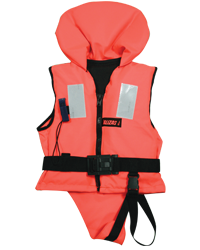
The 100Newton life jackets reduce the risk of drowning for both swimmers and non-swimmers in sheltered waters in most conditions. Specifically designed to turn the unconscious user face up and support the head. It provides an improved fit and maximum safety. A large flotation collar supports the user’s head for keeping the head out of water and its design provides the user’s return on time. The life jackets have a crotch strap for keeping the vest securely whilst in the water, while the small size also features fabric pampers. It includes, one webbing fastener, whistle, plastic zip and SOLAS retro reflective tapes. An end rope with plastic button is fixed at the end of each life jacket for adjustable wearing. Approved to the latest European standards for 100Newton life jackets, ISO 12402-4. All of its raw materials are certified per ISO 12402-7 and ISO 12402 -8, for higher strength, quality and durability. It is available in 6 sizes, in fluorescent orange color.

Foam Life Jacket 150N, CE ISO 12402-3:
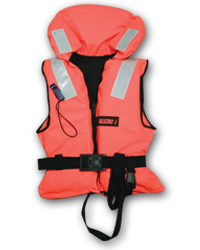
The 100Newton life jackets reduce the risk of drowning for both swimmers and non-swimmers in sheltered waters in most conditions. Specifically designed to turn the unconscious user face up and support the head. It provides an improved fit and maximum safety. A large flotation collar supports the user’s head for keeping the head out of water and its design provides the user’s return on time. The life jackets have a crotch strap for keeping the vest securely whilst in the water, while the small size also features fabric pampers. It includes, one webbing fastener, whistle, plastic zip and SOLAS retro reflective tapes. An end rope with plastic button is fixed at the end of each life jacket for adjustable wearing. Approved to the latest European standards for 100Newton life jackets, ISO 12402-4. All of its raw materials are certified per ISO 12402-7 and ISO 12402 -8, for higher strength, quality and durability. It is available in 6 sizes, in fluorescent orange colour.

Life belt 100N, CE ISO 12402-4::

The 100 Nt lifebelts have been designed for people who may have to wait for rescue, but are likely to do so in sheltered water. They have been tested and certified per the EN ISO 12402-4, EN ISO 12402-7 and EN ISO 12402-9 testing standards according to directive 89/686/ EC for recreational boats. They come equipped with a 30mm width waist webbing, 100cm² retro reflective tapes (IMO Resolution A.658(16)) and the EN ISO 12402-7 and EN ISO 12402-8 whistle approved.
ISO 12402 Life Belt Series
The series of ISO 12402 Lifebelts of 100Nt & 150Nt have been tested and certified per the EN ISO 12402-3, EN ISO 12402-4, EN ISO 12402-7 and EN ISO 12402-9 testing standards according to directive 89/686/ EC for recreational boats. They are equipped with a waist webbing of 30mm width, retro reflective tapes (IMO Resolution A.658 (16)) and the EN ISO 12402-7 & EN ISO 12402-8 whistle approved.

Life belt 150N, CE ISO 12402-3:
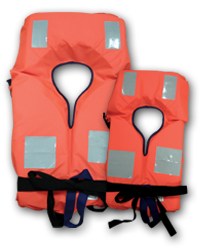
The 150 Nt lifebelts have been designed for general application or for use with full weather clothing. They are also capable to turn an unconscious person into a safe position and require no subsequent action by the user to maintain this position. The 150 Nt lifebelts have been tested and certified per the EN ISO 12402-3, EN ISO 12402-7 and EN ISO 12402-9 testing standards according to directive 89/686/ EC for recreational boats. They come equipped with a 30mm width waist webbing, 300cm2 retro reflective tapes (IMO Resolution A.658 (16)) and the EN ISO 12402-7 & EN ISO 12402-8 whistle approved.

Work Vest 50N, CE ISO 12402-5:
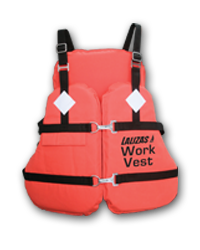
The work vest is specifically designed and constructed for use in the work environment. It is open on the side areas for light wearing and it features a polyester anti fire outer shell, while its buoyant material is soft PE. Its two waist webbings are adjusted by the stainless steel buckles, while the vest is fastened by using the stainless steel D-rings and hooks. It is provided with SOLAS retro reflective tapes. It has also a fabric pocket for placing tools or other light equipment. Approved to the latest European standards for 50 Newton buoyancy aids, ISO 12402-5. All of its raw materials are certified per ISO 12402-7 and ISO 12402 -8, for higher strength, quality and durability. It is available in one adult size and in orange color.

Life jackets Dry Bag:
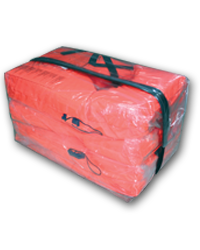
This simple and easy to use life jackets’ Dry-bag by Lalizas, stands out as the most intelligent and waterproof storage solution for all the necessary safety equipment of your boat. Made from durable transparent material, without any unnecessary seams, it meets the minimum space consumption requirements, and offers the ability of immediate use in case of an emergency or a boat inspection. It is specially designed for storing foam life jackets of 100N or 150N, while at the same time can secure all hand and smoke signals required by regulations, in the available space between the life jackets’ neck grooves. Available in 3 sizes, as well as 2 sets of a Dry Bag and 4 or 6 foam life jackets (100N) respectively.

ADVISOR - Life Jackets:
Use
100 Newton life jackets are intended for use in semi-protected
waters. Unlike buoyancy aids these life jackets can be used also by
non-swimmers. Given their importance as a lifesaving appliance, when
designing 100Newton life jackets, far more emphasis is given on the
safety aspect and less on the appearance. Their colour varies
between yellow and red and they have retro-reflective tapes in order
to be clearly visible from a distance. It is important to stress
that 100 Newton life jackets are not suitable for use offshore, in
these situations the use of 150 Newton life jackets is mandatory.
Instructions of Use
100 Newton life jackets may be either jackets or belts. A life
jacket is worn over the shoulders, zipped and then strapped. A
lifebelt is worn headfirst through the relevant cut and the strap
around your waist is fastened securely.
Maintenance / Replacement
While at sea the life jacket is a potential life-saver and as such
must be maintained well. For this reason, always, avoid extreme
temperatures, flame and any sharp surfaces. Also after each use, you
should wash it with clear lukewarm water.
You must always
maintain your buoyancy aid, and wear it at all times while at sea.
Lalizas products are manufactured following the highest construction
standards, this results in a high degree of effectiveness and
durability.
However, a jacket should be replaced
if:
- The seams on the
shoulders, on the side or the straps are worn out.
- The straps
have tears
- The clips are broken
- The outer shell of the
buoyancy aid is torn or has cuts
- To ensure your continual
safety, you should always keep your life jacket in good condition
and always wear it while afloat.
Usefull Hints before you set sail
Before you set sail, it is very important that
you follow the guidelines below:
1. Inform
the crew about the type, location and use of all safety equipment on
board
Every person on board should know where to
find and how to use:
- Safety harnesses and life
jackets
- Pyrotechnics & Fire Extinguishers
- Liferaft
-
VHF Radio (It is important that everyone knows how to send and
receive a radio distress message)
2. When
you plan your voyage, take into account
- Weather forecast
-
Tidal streams and heights
- Any harbors of refuge along the route
- You should explain the route to the crew informing them about all
of the above
3. Store
all your equipment securely
4. Check
the oil and water levels, carry out a test run of the engine. Also,
have on board a spare water pump impeller, spare fuel/oil filters
and a spare fan belt. Keep spare oil and fuel in separate tanks from
the main tank
5. Before
you set sail, check whether you have enough fuel, water, food and
gas for the trip
At Sea
1. Always
wear life jackets and use safety harnesses to avoid falling
overboard
2. Make
sure you are aware of man overboard recovery methods and practice
them frequently
3. Keep
up to date with current weather forecasts and be prepared to make
the necessary changes to your plans
4. If
it is windy, reef early, before leaving harbor if possible
5. Keep
a good all-round lookout and regularly update the chart with your
position
6. Keep
the boat tidy and check for any damage
7. If
the crew shows signs of cold or seasickness, keep them warm and
comfortable








